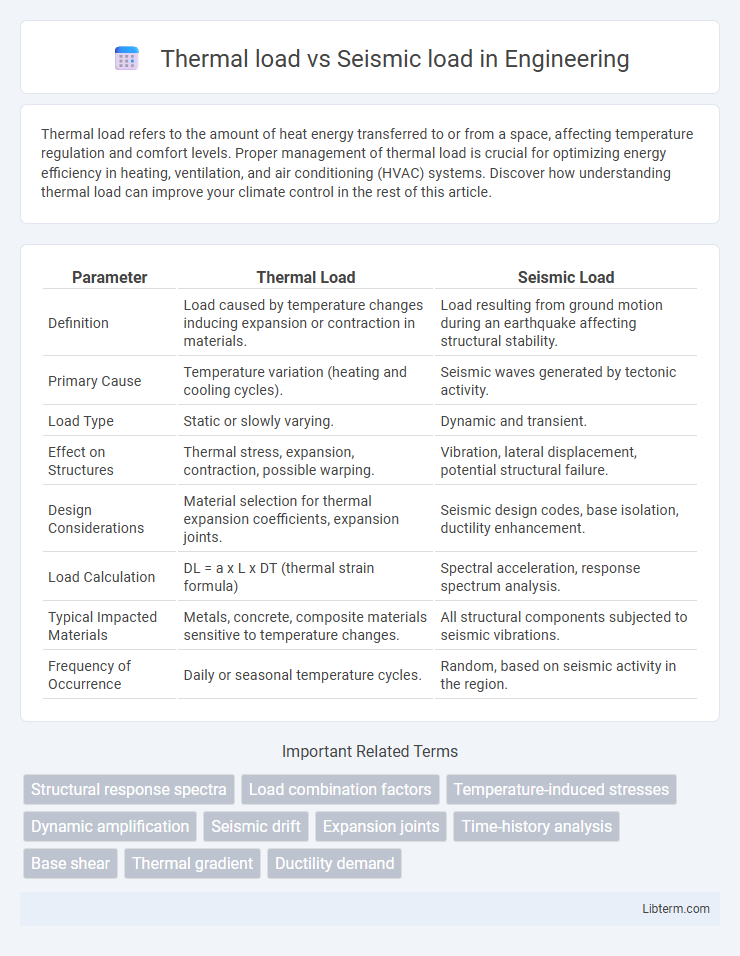Thermal load refers to the amount of heat energy transferred to or from a space, affecting temperature regulation and comfort levels. Proper management of thermal load is crucial for optimizing energy efficiency in heating, ventilation, and air conditioning (HVAC) systems. Discover how understanding thermal load can improve your climate control in the rest of this article.
Table of Comparison
| Parameter | Thermal Load | Seismic Load |
|---|---|---|
| Definition | Load caused by temperature changes inducing expansion or contraction in materials. | Load resulting from ground motion during an earthquake affecting structural stability. |
| Primary Cause | Temperature variation (heating and cooling cycles). | Seismic waves generated by tectonic activity. |
| Load Type | Static or slowly varying. | Dynamic and transient. |
| Effect on Structures | Thermal stress, expansion, contraction, possible warping. | Vibration, lateral displacement, potential structural failure. |
| Design Considerations | Material selection for thermal expansion coefficients, expansion joints. | Seismic design codes, base isolation, ductility enhancement. |
| Load Calculation | DL = a x L x DT (thermal strain formula) | Spectral acceleration, response spectrum analysis. |
| Typical Impacted Materials | Metals, concrete, composite materials sensitive to temperature changes. | All structural components subjected to seismic vibrations. |
| Frequency of Occurrence | Daily or seasonal temperature cycles. | Random, based on seismic activity in the region. |
Understanding Thermal Load in Structures
Thermal load in structures refers to stresses and deformations caused by temperature variations, which induce expansion or contraction in materials like steel and concrete. This load impacts the structural integrity by generating internal forces that may lead to cracking, warping, or even failure if not properly accommodated through expansion joints or material selection. Understanding thermal load is crucial for designing resilient buildings and infrastructure that withstand environmental temperature fluctuations alongside seismic load considerations.
Defining Seismic Load and Its Impact
Seismic load refers to the forces exerted on structures during an earthquake, resulting from ground acceleration and dynamic motion. This load significantly impacts structural design by demanding enhanced resilience, ductility, and energy dissipation capabilities to prevent catastrophic failure. Understanding seismic load is critical for developing building codes and engineering solutions that mitigate earthquake-induced damage and ensure occupant safety.
Fundamental Differences Between Thermal and Seismic Loads
Thermal loads result from temperature changes causing expansion or contraction in materials, leading to stress due to constrained deformation, while seismic loads are dynamic forces generated by ground motion during earthquakes, inducing inertial forces in structures. Thermal loads are typically static or slowly varying, affecting elements uniformly or with gradients, whereas seismic loads are transient, multidirectional, and highly dynamic, requiring time-dependent analysis. The fundamental difference lies in their origin--thermal loads arise from environmental temperature variations, whereas seismic loads stem from geophysical ground accelerations impacting structural stability and safety.
Sources and Causes of Thermal Loads
Thermal loads arise primarily from temperature variations causing material expansion or contraction in structures, influenced by direct solar radiation, ambient temperature fluctuations, and heat generated by operational equipment. Sources include diurnal and seasonal temperature changes, fire exposure, and thermal gradients within materials. These temperature-induced stresses differ fundamentally from seismic loads, which stem from ground motion during earthquakes.
Origin and Characteristics of Seismic Loads
Seismic loads originate from the sudden release of energy in the Earth's crust, causing ground shaking and inertial forces acting on structures during an earthquake. These loads are dynamic, irregular, and amplify based on the earthquake magnitude, distance from the fault, and local soil conditions. Unlike thermal loads, seismic loads involve rapid, multidirectional accelerations creating complex stress patterns that require specialized structural design for energy dissipation and resilience.
Structural Response to Thermal Load
Structural response to thermal load involves expansion or contraction of building materials due to temperature variations, which induces stress and strain within the framework. Unlike seismic load, which generates dynamic forces causing oscillations and potential structural failure, thermal load results in gradual deformation that may lead to warping, cracking, or buckling over time. Effective design incorporates expansion joints and flexible connections to accommodate thermal movements and maintain structural integrity.
Structural Behavior Under Seismic Load
Seismic load induces dynamic forces causing cyclic stresses and deformations that test a structure's ductility and energy dissipation capacity, unlike thermal load which primarily causes expansion or contraction without significant cyclic effects. Structural behavior under seismic load requires enhanced flexibility, strength, and damping mechanisms to prevent brittle failure and collapse. Engineering design prioritizes seismic resilience through reinforcement detailing, base isolation, and energy-absorbing devices to mitigate earthquake-induced damage.
Design Considerations for Thermal Effects
Thermal load design considerations focus on accommodating expansion and contraction due to temperature fluctuations, which can induce stress and deformation in structural elements. Materials with high thermal conductivity and low coefficient of thermal expansion are preferred to minimize thermal strain and ensure structural integrity. Expansion joints and flexible connections are essential to absorb thermal movements and prevent damage during service life.
Engineering Strategies for Seismic Load Resistance
Engineering strategies for seismic load resistance prioritize enhancing a structure's ductility, energy dissipation, and lateral stiffness through methods such as base isolation, shear walls, and moment-resisting frames. Unlike thermal loads, which induce expansion or contraction stresses primarily managed by expansion joints and material selection, seismic loads require dynamic analysis and design to withstand inertial forces and ground accelerations. Advanced modeling techniques, including nonlinear time-history analysis, optimize seismic resilience by predicting structural response under varying earthquake scenarios, ensuring safety and minimizing damage.
Integrating Thermal and Seismic Load Analysis in Building Design
Integrating thermal and seismic load analysis in building design enhances structural resilience by addressing temperature-induced expansions and contractions alongside earthquake forces. Advanced finite element modeling allows engineers to simulate combined loading scenarios, optimizing materials and connections to withstand both dynamic seismic events and gradual thermal stresses. This holistic approach reduces potential damage, ensures long-term structural integrity, and improves safety under multi-hazard conditions.
Thermal load Infographic

 libterm.com
libterm.com